Girls Have Fun With Chemistry at the WCC Girls Day Camp, Bonding With Chemistry
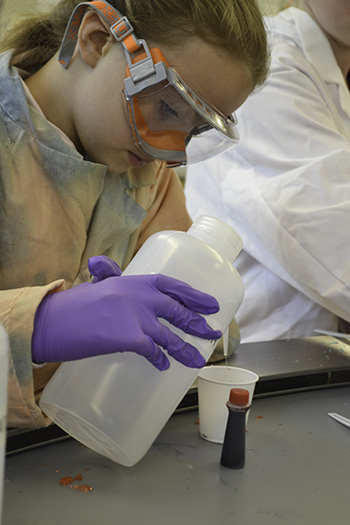 A camper in goggles engaging in hands-on activities at the Bonding With Chemistry camp.
A camper in goggles engaging in hands-on activities at the Bonding With Chemistry camp.July 13, 2017
This summer, the 10th annual WCC Girls Day Camp, Bonding With Chemistry, brought 90 rising 6th–8th grade girls to campus to do as its name suggests…bond with chemistry. Held at the Chemistry Annex from 9:00 am to 3:30 pm on both June 24th and July 8th, the day camp provided hands-on, chemistry-related activities for the 45 students who participated each Saturday.
The outreach was sponsored by the Women Chemists Committee (WCC) of the local chapter of the American Chemical Society. The WCC is comprised of 50–100 women (and men) who are interested in attracting, developing, promoting, and advocating for women in the chemical sciences. Funding for the camp was provided by the East Central Illinois American Chemical Society (ECI–ACS), and the Chemical Biology Interface (CBI).
Heading up this summer’s event were Michaela Carlson, a 4th year Chemistry graduate student, who was in her 3rd year helping with the event, and fellow Co-Chair Courtney Ford, also a 4th year grad student helping with the outreach for the 2nd year.
Here’s one indicator of how fun and engaging the camp is: some of the girls who have taken the camp in previous years came back again this year. According to the co-chairs, about 20% of the participants had attended the camp before.
While having repeat attenders is rewarding, it also makes for more work, since the camp volunteers must come up with brand new, hands-on activities. “We have new designs each year because we get a lot of repeats,” Carlson indicates, “so we want them to learn new things.”
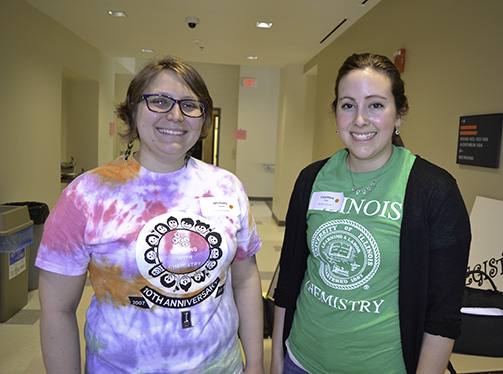 Chemistry graduate students Michaela Carlson and Courtney Ford.
Chemistry graduate students Michaela Carlson and Courtney Ford.Did any of the activities they planned involve blowing things up? “No,” Carlson indicates, laughing, “at least not planned.” But students did get to see some fire. As they were arriving, to get them in the mood, several Illinois chemistry grad students presented fun and engaging demonstrations—some involving fire, of course.
For most of the day, the girls rotated between five stations, spending about 45 minutes at each. One station during which the girls expressed their individual creativity was Tie-Dye Chromatography (the one station they repeat every year), during which the girls tie-dyed camp t-shirts and a tie-dyed a flower to take home, Other stations were: Cosmetic Chemistry, where the girls made cosmetics such as lip balm, sun screen, etc.; the Chemistry of Macromolecules, Symmetry & Chirality, and Nanochemistry, where the girls suited up in lab coats and goggles and did some lab work.
Also, to ensure that the middle-schoolers have sweet memories of the day, they were rewarded with candy every time they got an answer right during the chemistry game at lunch. Another cool thing about the day? The girls got some liquid nitrogen ice cream just before they went home.
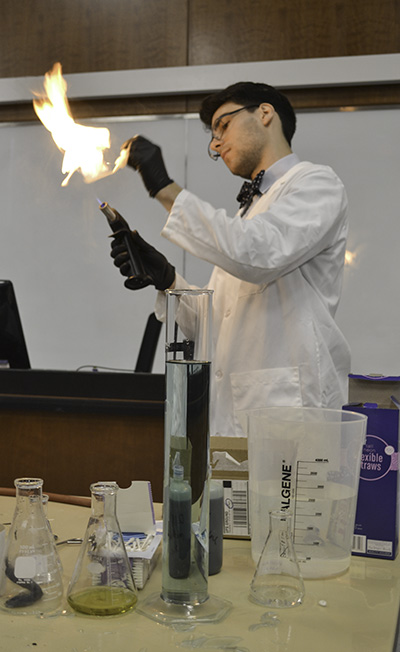 Illinois Chemistry graduate student presenting a demonstration for campers.
Illinois Chemistry graduate student presenting a demonstration for campers.In addition to Carson and Ford, numerous chemistry grad students volunteered, based on the amount of time they could contribute to the project. Some were involved months ahead of time, planning the stations; designing and ordering the t-shirts; compiling the experiments into a lab notebook the could students use, then take home. Some volunteers who couldn’t invest as much time, but still wanted to be involved, helped on the day of the event with the stations, which generally needed 3–5 folks in addition to those who planned them.
Ford and Carlson admit that their goal in doing the event is to target younger girls and get them interested in STEM in hopes that they remain interested as they get older.
“People always quote that the time when most girls kind of lose interest in going into STEM fields is right around middle school age,” acknowledges Ford. “So our goal of getting middle school girls to come in and have positive grad student roles models and also do all these fun, exciting hands-on activities is to help continue the interest in science and in chemistry.”
In order to pique and retain the girls’ excitement about chemistry even after the camp is over, Carlson indicates that they’re also intentional regarding the different components of the day camp—such as the lab notebooks and even the different experiments they choose.
“Yeah, part of the reason we do the lab notebooks is so that they can take that home and repeat some of the experiments as well. So generally we do household items so they'll be able to do that. We also give them goodie bags of fun chemistry things. So sometimes there are little journals that talk about the chemistry and the environment, or whatever is going on, that are aimed at middle schoolers.”
She adds that they’re also intentional about the cost, in hopes of enabling the underserved to participate: “This camp is completely free for the participants! We provide lunch, and everything is free for them. We really want to draw in as many people as possible, and don't want anyone to be excluded.”
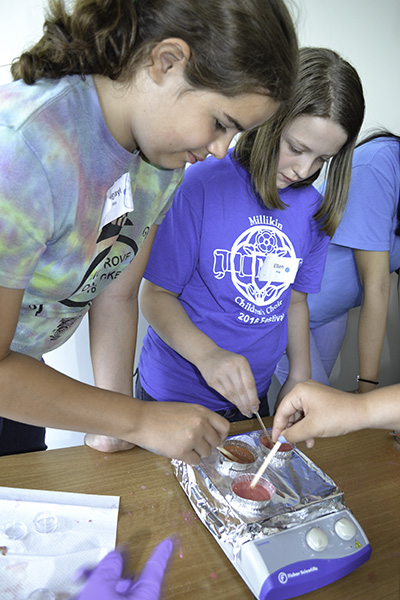 Campers engaging in hands-on activities.
Campers engaging in hands-on activities.So to recruit from a broad spectrum of participants, the co-chairs contacted 23 middle schools in the area, plus sent out an announcement on the university’s e-week listserv. While most of the participants were local, several came from as far away as Chicago.
"“This is a great way of getting middle school aged girls interest in science,” Carlson acknowledges, “and continue their interest in science. We try and make it so students can come and take some of these experiments home and show their parents, so that they don't forget about it the day after. So we really want this to be something that they look back on fondly, and by the rate of return we get (we get about 20% come back), obviously we're doing something right.”
Another proof that they’re doing something right: Bonding With Chemistry is, after all, in its 10th year. But how about when this reporter’s granddaughter gets old enough to participate in the camp in two years? “It will still be going on,” Carlson avows.
Story and photographs by Elizabeth Innes, Communications Specialist, I-STEM Education Initiative.
More: 6-8 Outreach, Chemistry, Summer Camp, Women in STEM, 2017
For additional I-STEM articles on Engineering camps and outreach activities, see:
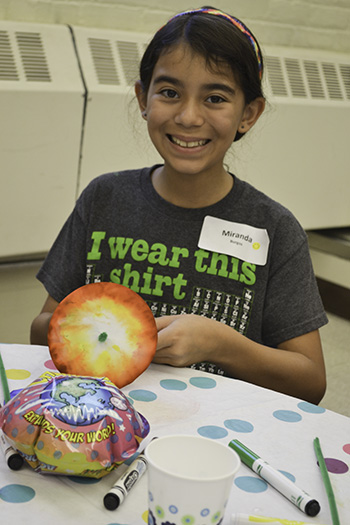
A camper expresses creativity at the camp.

A Bonding With Chemistry camper in goggles and a lab coat.
 A camper at the Tie-Dye Chromatography station.
A camper at the Tie-Dye Chromatography station. A camper engaging in a demonstration using fire.
A camper engaging in a demonstration using fire.
Graduate students helping campers with different camp activities.













.jpg)
















